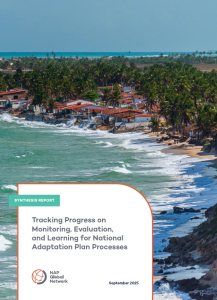Monitoring, evaluation, and learning (MEL) enable a better understanding of whether climate change adaptation actions work, how, and for whom. They also help to assess whether the actions will continue to work in the future.
MEL systems aim to inform adaptation policies and practices from the data and evidence generated by the iterative process of tracking, assessing, and learning throughout the NAP process.
MEL is both a distinct phase of the NAP process and an ongoing set of activities that are carried on throughout its other phases. As shown in the figure below, the three components of a MEL system interact with each other and the NAP process.
Countries should establish and strengthen national MEL systems that integrate gender equality and social inclusion; make strategic linkages between national and local levels; and are aligned with other global climate change and development processes (e.g., the Paris Agreement, Sendai Framework for Disaster Risk Reduction, and Sustainable Development Goals).
Our technical support on MEL for national adaptation covers five key areas:
- designing and revising MEL systems: clarifying and reviewing the purpose of MEL systems, what needs to be measured, for whom, why, and next steps.
- data, information, and knowledge management: strengthening and implementing the assessments and tools needed to generate evidence throughout the NAP process for effective MEL systems.
- adaptation indicators: identifying and applying indicators for tracking progress in adaptation over time.
- evaluating and reporting on progress: analyzing data across multiple sources to review and report progress and to evaluate the effectiveness, impact, and performance of NAP processes.
- Learning: identifying and implementing activities to learn from the generated evidence from MEL systems with the aim of informing local and national decisions and global agreements.




